What Are AI Agents? A Comprehensive Guide in 2025
AI agents are autonomous systems that process data, make decisions, and perform tasks using machine learning, NLP, and automation. They go beyond chatbots to enable complex workflows in industries like finance, healthcare, and e-commerce, improving efficiency and decision-making.
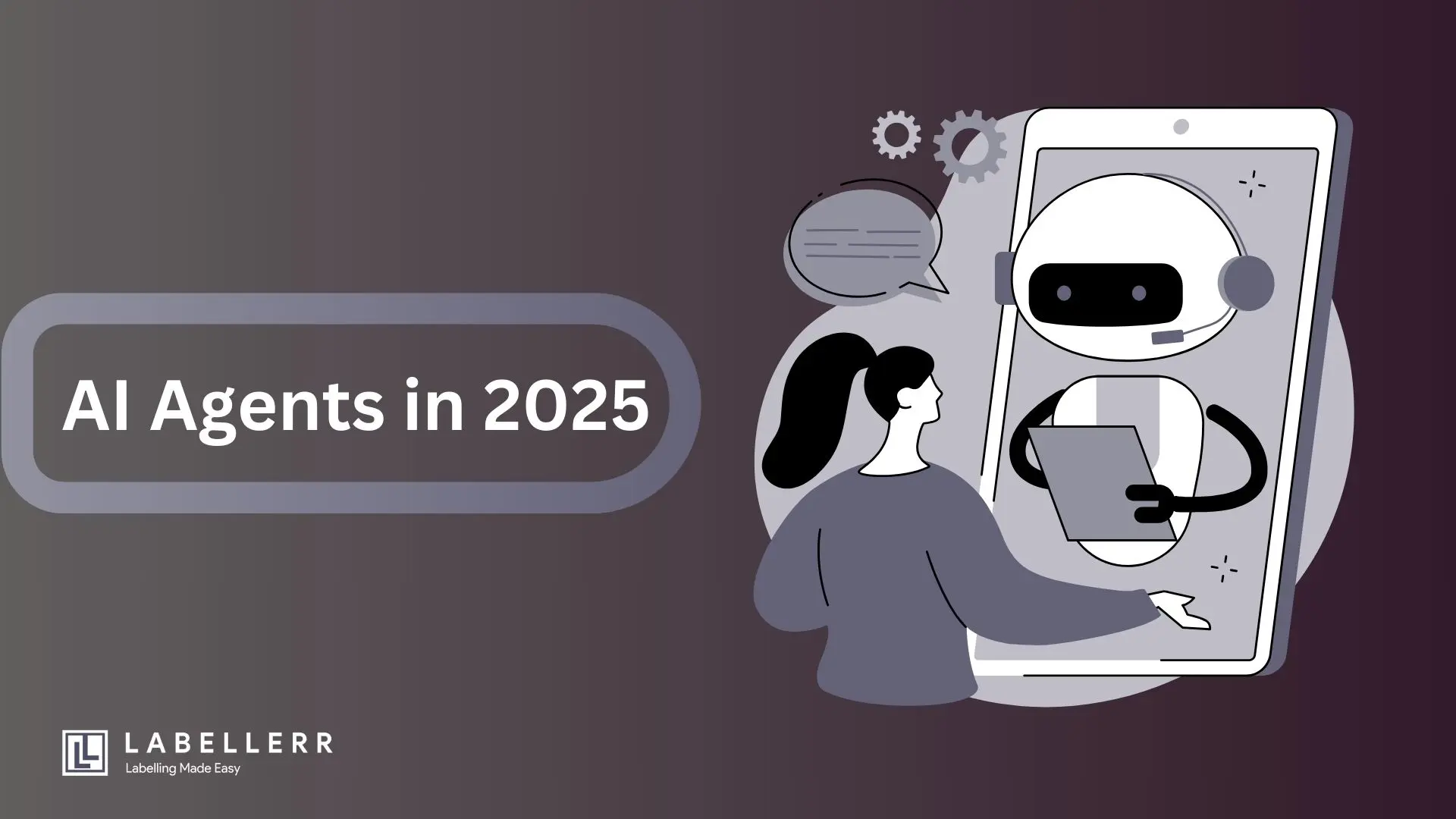
Artificial Intelligence (AI) agents are transforming how businesses operate, automate tasks, and interact with data. These agents are designed to perceive their environment, make decisions, and take actions to achieve specific goals.
The AI agent market is growing rapidly, with projections estimating an increase from $5.1 billion in 2024 to $47.1 billion by 2030.
This growth is driven by advancements in machine learning, large language models (LLMs), and automation technologies that enable AI agents to perform increasingly complex tasks.
Companies across various industries are integrating AI agents to streamline workflows, enhance productivity, and reduce operational costs.
Whether in IT automation, customer support, finance, healthcare, or autonomous systems, AI agents are playing a crucial role in making processes more efficient.
This guide explores what AI agents are, their evolution, capabilities, architecture, and how they function in real-world applications.
Table of Contents
- What are AI Agents?
- Types and Classifications of AI Agents
- Core Technologies Behind AI Agents
- AI Agent Architectures
- Applications of AI Agents Across Industries
- Leading AI Agent Frameworks and Tools
- Benefits and Risks of AI Agents
- Ethical and Societal Considerations
- Future Trends and Innovations
- Research and Development in 2025
- Implementation Strategies
- Conclusion
- FAQs
What are AI Agents?
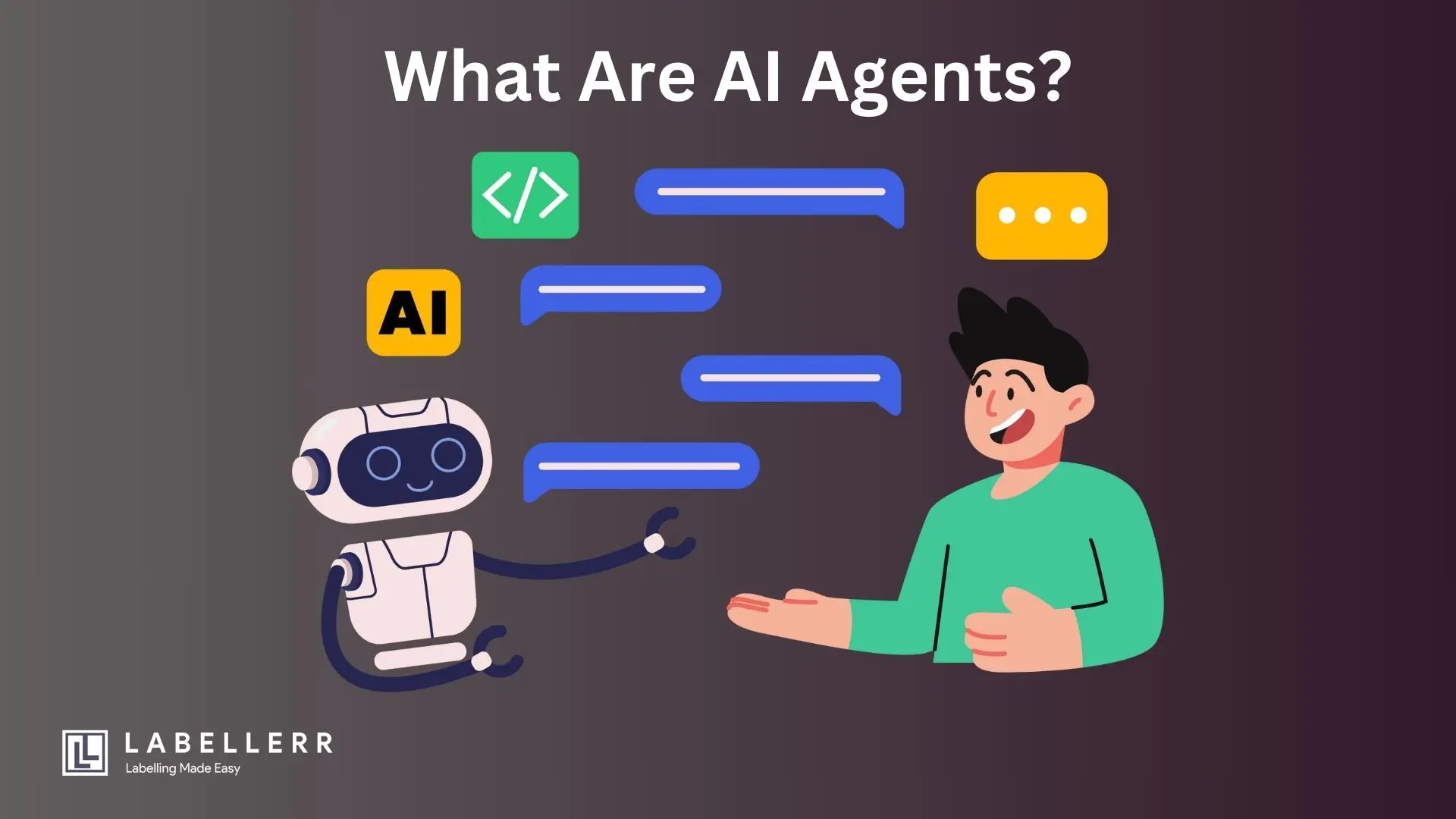
An AI agent is an intelligent system that can perceive data, analyze it, make decisions, and take action autonomously.
These agents interact with their environment through sensors (input sources like text, images, or real-world data) and effectors (outputs like text generation, robotic movements, or automated decisions).
Unlike traditional software, AI agents are dynamic and adaptive. They are designed to learn from experience, adjust their responses based on feedback, and operate independently without human intervention.
AI agents come in various forms, from chatbots and recommendation engines to self-driving car systems and industrial automation bots.
Key Characteristics of AI Agents

- Autonomy – Operate without continuous human input.
- Perception – Process information from text, images, speech, or real-time data.
- Decision-Making – Evaluate possible actions and choose the best approach.
- Learning Ability – Improve over time using machine learning and reinforcement learning.
- Interaction – Communicate with humans, software systems, or other AI agents.
Evolution of AI Agents: From LLMs to Autonomous Systems
AI agents have evolved significantly over the years, moving from basic rule-based systems to advanced autonomous AI-driven systems powered by LLMs and deep learning.
Early AI Agents (Rule-Based Systems)
- Followed predefined rules and if-then logic.
- Lacked adaptability and could not learn from new data.
- Example: Basic chatbots and automated scripts in customer support.
AI Agents Powered by Machine Learning
- Analyzed patterns and made predictions using machine learning.
- Improved decision-making but still relied on human-curated data.
- Example: Recommendation systems in e-commerce platforms.
LLM-Powered AI Agents
- Large language models (LLMs) enabled AI agents to understand, generate, and process human-like responses.
- Could analyze vast datasets, interact conversationally, and improve accuracy.
- Example: AI-powered virtual assistants like ChatGPT or AI-driven customer service bots.
Autonomous AI Agents
- Learn from experience, make independent decisions, and operate across multiple environments.
- Reinforcement learning and multi-agent collaboration enable agents to work together in logistics, finance, and self-driving technology.
- Example: Autonomous trading bots, AI-driven business process automation, and self-driving AI systems.
Anatomy of an AI Agent
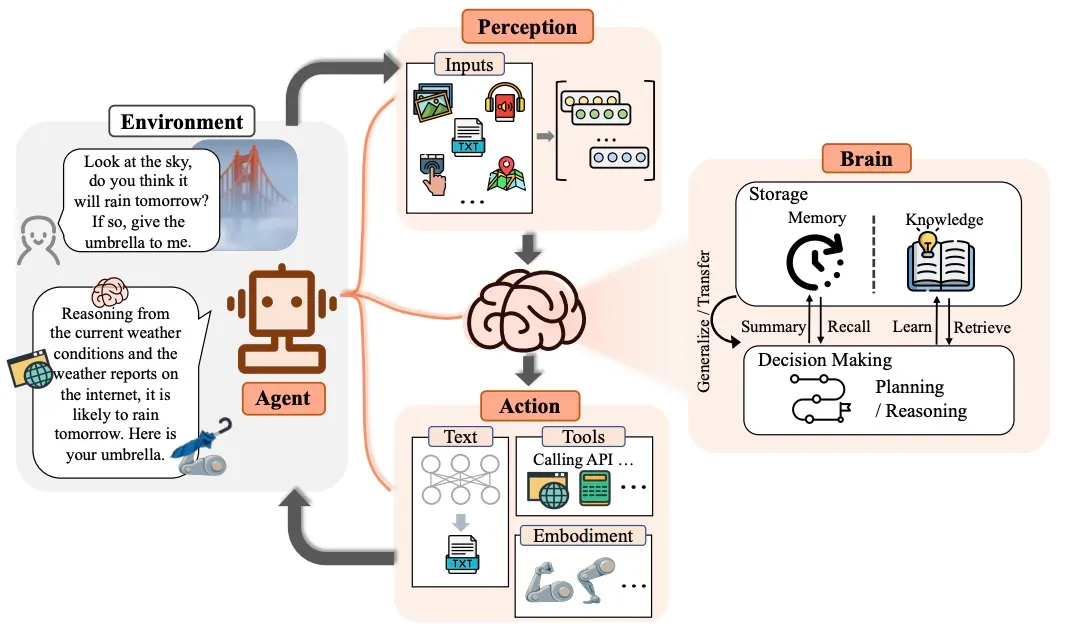
AI agents are built using a structured architecture that includes various components for perception, processing, decision-making, and execution.
Core Components of AI Agents:
- Perception Module (Input)
- AI agents gather data from text, voice, images, or external systems.
- Example: Sensors in self-driving cars collecting real-time road data.
- Processing & Decision-Making Module
- AI models analyze data, predict outcomes, and select actions.
- Example: A financial AI agent evaluating investment risks.
- Action Module (Output)
- AI agents execute actions based on decisions.
- Example: An AI-powered marketing automation tool sending personalized emails.
- Learning Module
- AI agents improve over time using reinforcement learning and data feedback.
- Example: AI chatbots becoming better at responding to complex user queries.
AI Agentic Workflow:
- Data Collection – AI agents gather input from multiple sources.
- Data Processing – AI models analyze and extract meaningful insights.
- Decision-Making – AI agents evaluate different possibilities and choose the best response.
- Action Execution – The agent applies its decision to real-world tasks.
- Learning & Feedback Loop – AI agents improve through reinforcement learning.
Types and Classifications of AI Agents
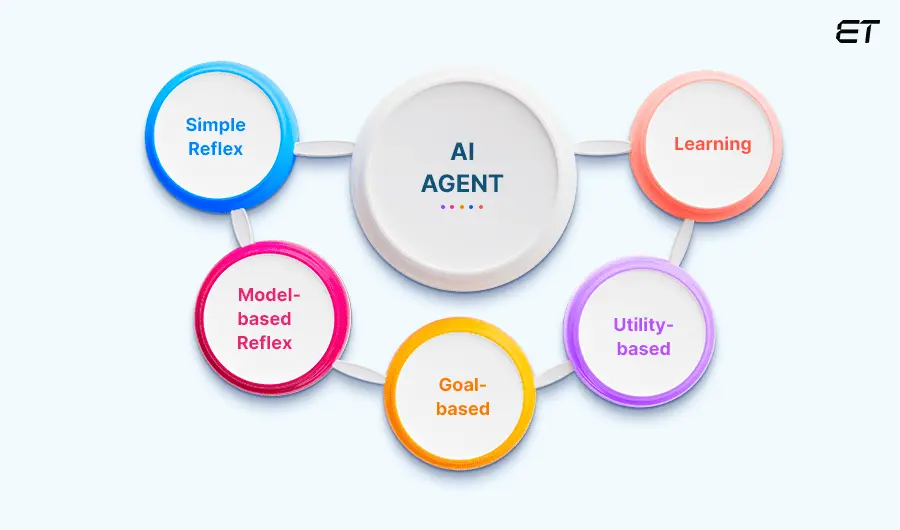
AI agents come in different forms based on their intelligence, functionality, and application.
Some are designed to perform simple tasks, while others can handle complex decision-making and automation. Understanding these classifications helps businesses and researchers choose the right AI agent for their needs.
By Intelligence Level
AI agents vary in intelligence, from basic rule-based systems to advanced learning agents that improve over time.
Simple Reflex Agents

Simple reflex agents make decisions based only on the current input. They do not remember past experiences or predict future outcomes. These agents react directly to situations using predefined rules.
Example: A thermostat that turns on the heater when the temperature drops below a set point. It only responds to the current temperature and does not consider past or future conditions.
Key Features:
- Reactive Behavior: Acts immediately based on current input.
- Limited Scope: Suitable for simple tasks with clear cause-and-effect.
- Fast Response: Makes quick decisions.
- No Learning Ability: Cannot adapt or improve over time.
Model-Based Reflex Agents

Model-based reflex agents are more advanced than simple reflex agents. They maintain an internal model of the environment, allowing them to use past data and predict future outcomes.
Example: Self-driving cars use model-based reflex agents to react to road conditions and also consider traffic rules, maps, and past experiences.
Key Features:
- Adaptive: Uses past information and current input for better decisions.
- Predictive: Anticipates future situations.
- Handles Complexity: Suitable for dynamic environments.
- Requires More Resources: Needs memory and processing power.
Goal-Based Agents

Goal-based agents work towards achieving specific goals. They do not just react to inputs but evaluate actions based on how well they help reach their goals.
Example: A delivery robot that plans the best route to deliver a package. It considers its current position, obstacles, and available paths to choose the quickest way.
Key Features:
- Purposeful Actions: Driven by set goals.
- Strategic Planning: Considers future outcomes when making decisions.
- Flexible: Can adjust goals if needed.
- Thinks Ahead: Evaluates long-term results of actions.
Utility-Based Agents

Utility-based agents focus on getting the best possible outcome by evaluating different options. They use a utility function to measure how good each action is, considering factors like cost, benefit, and risk.
Example: An investment AI that suggests financial options based on potential returns, risks, and the investor’s needs.
Key Features:
- Makes Trade-Offs: Evaluates multiple criteria to choose the best action.
- Quantitative Approach: Uses numbers to measure the desirability of outcomes.
- Optimizes Results: Seeks the most beneficial outcome.
- Handles Uncertainty: Works well in complex situations.
Learning Agents

Learning agents improve over time by learning from their experiences. They adjust their actions based on feedback and can adapt to new situations.
Example: An e-commerce recommendation system that learns from customer behavior and improves its suggestions.
Key Features:
- Adaptive Learning: Learns from data and feedback.
- Flexible: Can handle new tasks and environments.
- Balances Exploration and Use: Tries new strategies while using proven ones.
- Improves Over Time: Continuously enhances performance.
Hierarchical Agents
Hierarchical agents break down complex tasks into smaller, manageable parts. They organize decision-making into different levels, with higher levels guiding lower ones.
Example: A robot where the top level plans tasks while lower levels handle movement and object detection.
Key Features:
- Structured Approach: Organizes tasks into layers.
- Efficient Problem Solving: Tackles big tasks by managing smaller subtasks.
- Systematic Decisions: Ensures a clear and organized workflow.
By Functionality
AI agents can also be categorized based on the specific tasks they perform.
Conversational Agents
These agents interact with humans using natural language processing (NLP). They can answer questions, assist customers, and provide information.
- Example: Chatbots like ChatGPT, and virtual assistants like Siri, or Google Assistant.
Task-Oriented Agents
These agents focus on automating specific workflows and decision-making processes. They help businesses improve efficiency by handling repetitive or rule-based tasks.
- Example: AI-powered HR software that automates resume screening and interview scheduling.
Multi-Agent Systems (MAS)
These systems consist of multiple AI agents that collaborate to complete tasks. Each agent has its role, and they communicate to achieve complex objectives.
- Example: AI-powered logistics networks optimizing warehouse management and delivery routes.
By Application
AI agents are built for different levels of adaptability and industry needs.
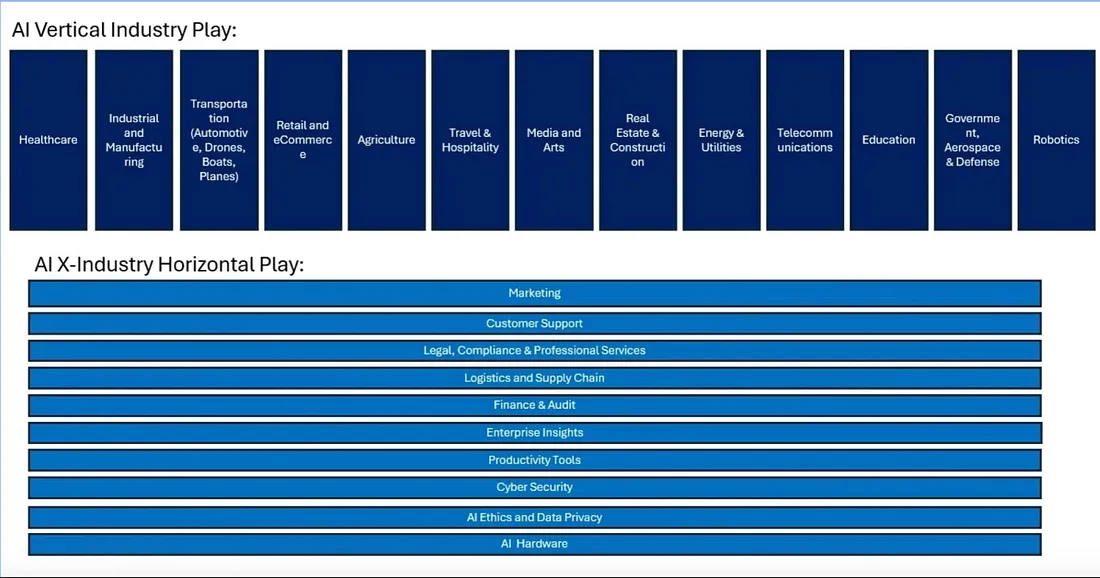
General-Purpose vs. Vertical AI Agents
- General-purpose AI agents can perform a wide range of tasks across different industries. They are flexible and adaptable but may require fine-tuning for specific use cases.
- Example: AI-powered cloud platforms offering machine learning services for multiple industries.
- Vertical AI agents are specialized for a particular industry or application. They are optimized for specific workflows and deliver more accurate results in those areas.
- Example: AI agents designed for medical imaging, finance, or cybersecurity.
Autonomous Agents vs. Semi-Autonomous Agents
- Autonomous agents operate independently with minimal human intervention. They make decisions, execute actions, and adapt to new situations.
- Example: Self-driving vehicles making real-time navigation decisions without human input.
- Semi-autonomous agents require human oversight for critical decisions. They assist in automation but rely on human input for complex or high-risk scenarios.
- Example: AI-powered diagnostic tools in healthcare that suggest treatment options but require doctor approval.
Core Technologies Behind AI Agents
AI agents rely on a combination of advanced technologies to function effectively. These technologies allow them to process information, make decisions, learn from experiences, and interact with humans and other systems.
Understanding these core technologies helps in designing better AI systems that can adapt to real-world challenges.
Role of Large Language Models (LLMs)
Large language models (LLMs) serve as the foundation for many AI agents, enabling them to understand and generate human-like text.
These models, trained on massive datasets, help AI agents with tasks such as answering questions, writing content, summarizing information, and engaging in natural conversations.
AI agents that use LLMs can interpret complex queries, extract relevant details, and generate meaningful responses.
The ability to fine-tune these models for specific tasks makes them highly adaptable across various industries, from customer service to research and development.
For example, chatbots and virtual assistants powered by LLMs, such as OpenAI's ChatGPT, help businesses automate customer interactions and improve efficiency. Similarly, AI-driven coding assistants use LLMs to generate, review, and optimize programming code.
Memory Systems: Short-Term vs. Long-Term
Memory plays a crucial role in AI agents, allowing them to retain and recall information when making decisions. AI agents use both short-term and long-term memory to enhance their performance.
- Short-term memory helps AI agents store temporary information, such as recent user inputs in a conversation. It allows the agent to maintain context and provide relevant responses without having to relearn previous exchanges.
- Long-term memory enables AI agents to retain historical data, user preferences, and past interactions. This improves personalization, learning efficiency, and decision-making over time.
For example, an AI assistant for e-commerce can remember a customer’s shopping preferences and recommend products based on past purchases.
Similarly, an AI-driven research assistant can recall previous findings and suggest relevant information without repeating past searches.
Planning and Reasoning Modules
AI agents need the ability to plan actions and make logical decisions based on their environment. Planning and reasoning modules allow them to analyze situations, predict possible outcomes, and choose the best course of action.
- Planning modules help AI agents break down tasks into smaller steps and determine the most efficient way to achieve a goal. This is crucial for robotics, self-driving cars, and industrial automation.
- Reasoning modules allow AI agents to interpret new information, apply logical rules, and solve complex problems. They help AI systems adjust to changing environments, ensuring adaptability and accuracy.
For example, in healthcare, AI agents use reasoning modules to suggest treatment plans based on a patient’s medical history and current symptoms. In logistics, AI-powered supply chain systems use planning algorithms to optimize delivery routes and reduce delays.
Action Execution and Tool Integration
AI agents must interact with digital and physical environments to perform tasks. This requires a combination of action execution capabilities and integration with external tools and APIs.
- Action execution involves translating AI-generated decisions into real-world actions. AI agents can execute tasks such as scheduling meetings, sending emails, operating machinery, or managing workflows.
- Tool integration allows AI agents to connect with business software, IoT devices, and cloud platforms to automate processes. Many AI agents integrate with databases, CRM systems, and analytics tools for real-time decision-making.
For example, AI-powered IT service management (ITSM) systems can automatically resolve technical issues by diagnosing errors and triggering corrective actions.
Similarly, AI agents in finance can integrate with stock market databases to execute real-time trades based on market trends.
Learning Strategies
AI agents improve over time through different learning strategies. These approaches help them refine their decision-making and become more efficient in handling tasks.
Reinforcement Learning
Reinforcement learning (RL) enables AI agents to learn by interacting with their environment and receiving feedback in the form of rewards or penalties. Over time, they refine their strategies to maximize positive outcomes.
For example, AI-powered robots in warehouses learn to optimize object handling by receiving feedback on successful or failed actions. In gaming, AI agents use RL to master complex strategies, as seen in AI models that play chess or Go at superhuman levels.
Learning from Human Feedback
AI agents can also improve based on direct input from human users. Human feedback helps refine AI behavior, ensuring responses align with expectations and ethical guidelines.
For example, AI-powered customer support chatbots learn from user interactions by recognizing common queries and improving response accuracy.
Similarly, AI-driven content moderation systems use human-labeled examples to detect inappropriate content more effectively.
Environment-Driven Adaptation
AI agents that operate in dynamic environments must adapt based on new information. They continuously update their understanding and refine their strategies based on real-time data.
For example, AI-powered recommendation engines adjust product suggestions based on changing user preferences and market trends. In cybersecurity, AI agents monitor network activity, detect emerging threats, and adjust security protocols accordingly.
AI Agent Architectures
AI agents rely on structured architectures that define how they function, learn, and interact with their environment.
These architectures include different modules that handle specific tasks like profiling, memory storage, planning, and action execution.
Understanding these components helps in designing AI agents that are efficient, reliable, and capable of adapting to real-world challenges.
Profiling Module: Role Assignment and Identity
The profiling module assigns specific roles to AI agents based on their intended tasks and responsibilities. This module helps determine how an AI agent interacts with users, responds to inputs, and makes decisions.
- Role assignment defines whether an AI agent functions as a customer service assistant, a research assistant, or an autonomous decision-maker in industries like finance or healthcare.
- Identity management ensures that AI agents maintain consistency in responses and personalization across interactions.
AI agents designed for customer service, for example, need to remember past user interactions to provide personalized recommendations.
For instance, an AI-powered recruitment agent profiles candidates based on job descriptions and hiring preferences.
Similarly, AI agents in e-commerce use profiling to provide personalized shopping experiences by analyzing customer preferences and purchase history.
Memory Module: Structures and Formats
Memory plays a crucial role in AI agents, enabling them to store and retrieve information for future interactions. AI memory systems are structured in different ways to optimize performance.
- Short-term memory stores temporary information such as recent conversations, helping AI agents maintain context within a session.
- Long-term memory retains important historical data, allowing AI agents to learn from past interactions and improve over time.
- Knowledge graphs help AI agents organize information in structured formats, making it easier to retrieve relevant data when needed.
For example, AI agents in healthcare store patient medical records, allowing them to provide better diagnosis recommendations over time.
In business automation, AI agents remember past customer complaints and preferences to offer a seamless support experience.
Planning Module: Feedback vs. Feedback-Free Strategies
AI agents rely on planning modules to make informed decisions and execute tasks efficiently. These modules use different strategies to determine the best course of action.
- Feedback-based planning allows AI agents to adjust their actions based on real-time feedback from users or external systems.
This method is useful in applications like chatbots, where the AI learns from user responses to improve future interactions. - Feedback-free planning relies on predefined rules and algorithms, executing tasks without the need for external input. This is often used in industrial automation, where AI agents follow fixed workflows to streamline operations.
For example, AI-powered cybersecurity agents use feedback-based planning to adapt to emerging threats by analyzing attack patterns.
In contrast, warehouse robots use feedback-free planning to sort and organize inventory based on predefined logistics rules.
Action Module: Targets, Strategies, and Execution
The action module defines how AI agents interact with their environment and execute decisions. This module includes:
- Target identification, which determines the goal of the AI agent's action. For example, an AI assistant in sales may aim to close a deal, while a robotic AI agent may aim to assemble a product.
- Strategy selection, where AI agents determine the best approach to achieve their objectives. This involves evaluating multiple options and selecting the most effective one.
- Execution mechanisms, where AI agents carry out tasks based on selected strategies. AI agents may trigger workflows, send notifications, or physically manipulate objects in the case of robotics.
For instance, AI-powered autonomous vehicles analyze road conditions, determine safe driving strategies, and execute actions like braking or changing lanes. In marketing, AI agents identify potential leads, determine the best outreach strategy, and execute automated email campaigns.
Applications of AI Agents Across Industries
AI agents are transforming various industries by automating tasks, improving efficiency, and enhancing decision-making.
Their ability to analyze vast amounts of data, learn from interactions, and execute tasks autonomously makes them valuable tools in multiple sectors.
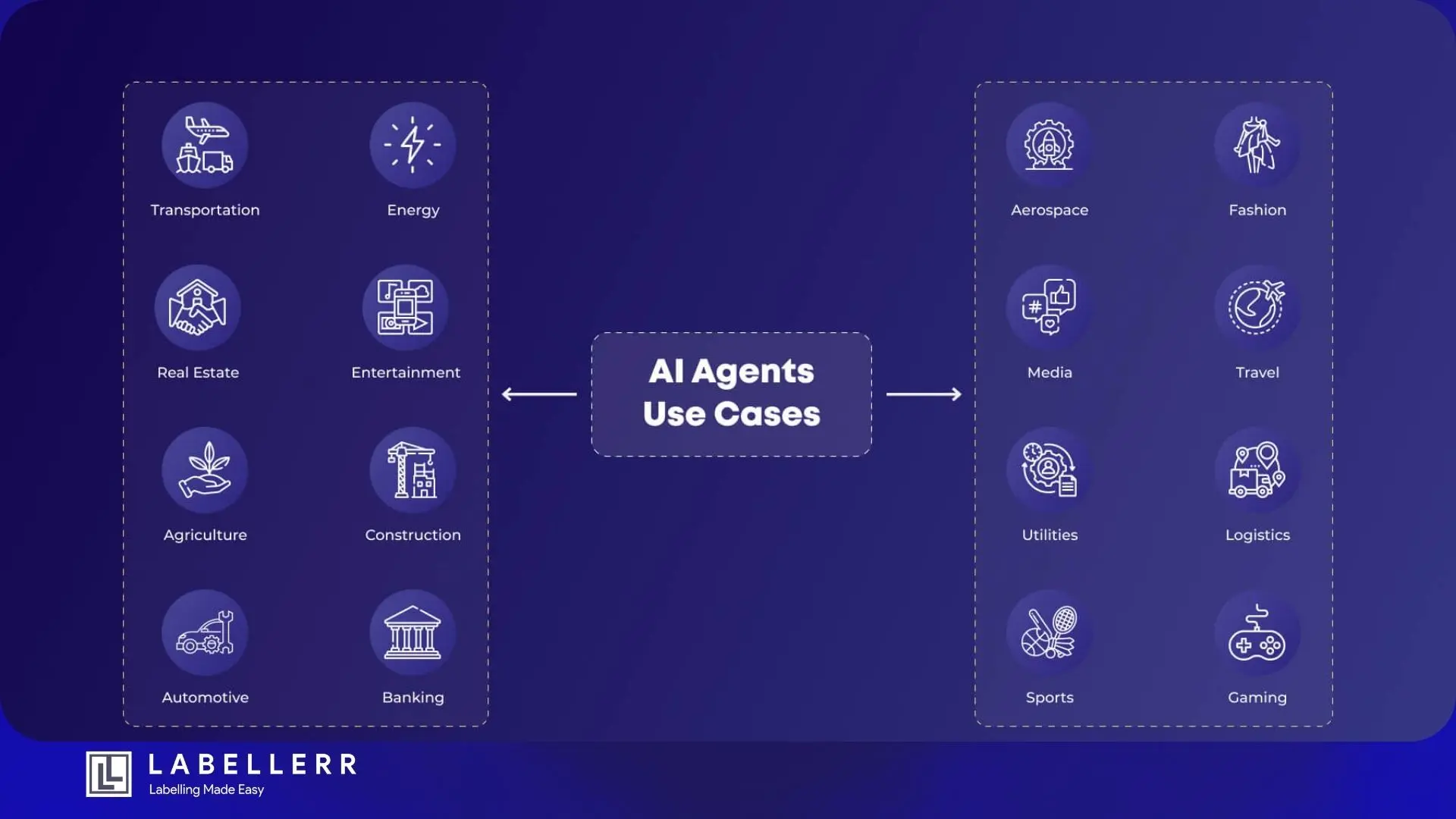
E-Commerce
AI agents in e-commerce improve customer experience and streamline business operations.
- Personalized Recommendations: AI agents analyze customer behavior, browsing history, and purchase patterns to suggest relevant products.
This improves user engagement and increases sales. Companies like Amazon and Shopify use AI-driven recommendation engines to enhance customer shopping experiences. - Order Automation and Customer Support: AI agents handle tasks such as order processing, inventory management, and logistics coordination.
Chatbots provide 24/7 customer service, answering inquiries and resolving issues instantly. This reduces response time and increases customer satisfaction.
Healthcare
AI agents are revolutionizing healthcare by assisting medical professionals and improving patient care.
- Diagnosis Assistance: AI-powered tools analyze medical images, detect diseases, and provide diagnostic support.
These agents help doctors identify conditions like cancer, fractures, and neurological disorders with greater accuracy.
AI-driven platforms like IBM Watson assist in diagnosing complex cases based on medical data. - Patient Monitoring: AI agents track patient vitals, detect anomalies, and alert healthcare providers to potential health risks. Remote monitoring systems use AI to analyze real-time data from wearable devices, ensuring early intervention for critical conditions.
Finance
The finance industry benefits from AI agents by enhancing security and optimizing trading strategies.
- Fraud Detection: AI agents analyze transaction patterns and detect suspicious activities to prevent fraud.
By using machine learning algorithms, banks and financial institutions can identify anomalies in real-time and block unauthorized transactions. - Algorithmic Trading: AI agents make split-second investment decisions based on market trends and financial data.
These automated trading systems execute high-speed transactions with precision, maximizing profits and minimizing risks.
Hedge funds and financial firms rely on AI-driven algorithms for stock trading and portfolio management.
Manufacturing
AI agents increase efficiency in manufacturing by reducing downtime and improving product quality.
- Predictive Maintenance: AI agents analyze equipment performance data to predict potential failures.
This proactive approach prevents unexpected breakdowns and reduces maintenance costs.
AI-powered maintenance systems ensure that machinery runs smoothly, avoiding costly disruptions. - Quality Control: AI agents inspect products for defects using computer vision and machine learning. Automated quality control systems detect inconsistencies in manufacturing lines, ensuring that only high-quality products reach the market.
Marketing
AI agents help businesses optimize marketing campaigns and understand customer sentiment.
- Ad Campaign Automation: AI agents analyze consumer behavior and automatically adjust ad targeting strategies. They optimize ad placements across social media and search engines, increasing the effectiveness of digital marketing campaigns.
- Sentiment Analysis: AI agents process customer reviews, social media posts, and feedback to determine public sentiment toward a brand.
Companies use this information to improve products, manage brand reputation, and address customer concerns.
Human Resources
AI agents streamline HR processes, making recruitment and employee management more efficient.
- Recruitment Automation: AI-powered tools scan resumes, shortlist candidates, and schedule interviews.
By automating these processes, HR teams save time and focus on engaging with top candidates. AI-driven platforms like LinkedIn Talent Solutions help companies find the best talent efficiently. - Employee Onboarding: AI agents assist new hires by providing training materials, answering common questions, and guiding them through company policies.
Automated onboarding systems reduce administrative tasks and enhance the employee experience.
Software Development
AI agents are transforming software development by automating coding tasks and debugging processes.
- Code Generation: AI agents assist developers by generating code snippets, reducing manual effort. AI-powered tools like GitHub Copilot suggest code based on user inputs, improving productivity.
- Debugging and Version Control: AI agents detect coding errors and recommend fixes, minimizing development delays. Version control systems use AI to track changes, resolve conflicts, and maintain clean code repositories.
Gaming
AI agents enhance the gaming experience by creating realistic interactions and dynamic storylines.
- Adaptive NPCs: AI-powered non-player characters (NPCs) adapt their behavior based on player actions, creating more immersive gameplay.
AI agents enable NPCs to learn, strategize, and interact dynamically, making games more engaging. - Dynamic Storylines: AI-driven storytelling adjusts game narratives based on player choices. Games with AI-generated content offer unique experiences, ensuring replayability and personalization.
Leading AI Agent Frameworks and Tools
AI agent frameworks and tools are essential for developing intelligent systems that can perform complex tasks autonomously. Two notable examples are Simular AI's Agent S and Landing AI's VisionAgent.
Simular AI's Agent S
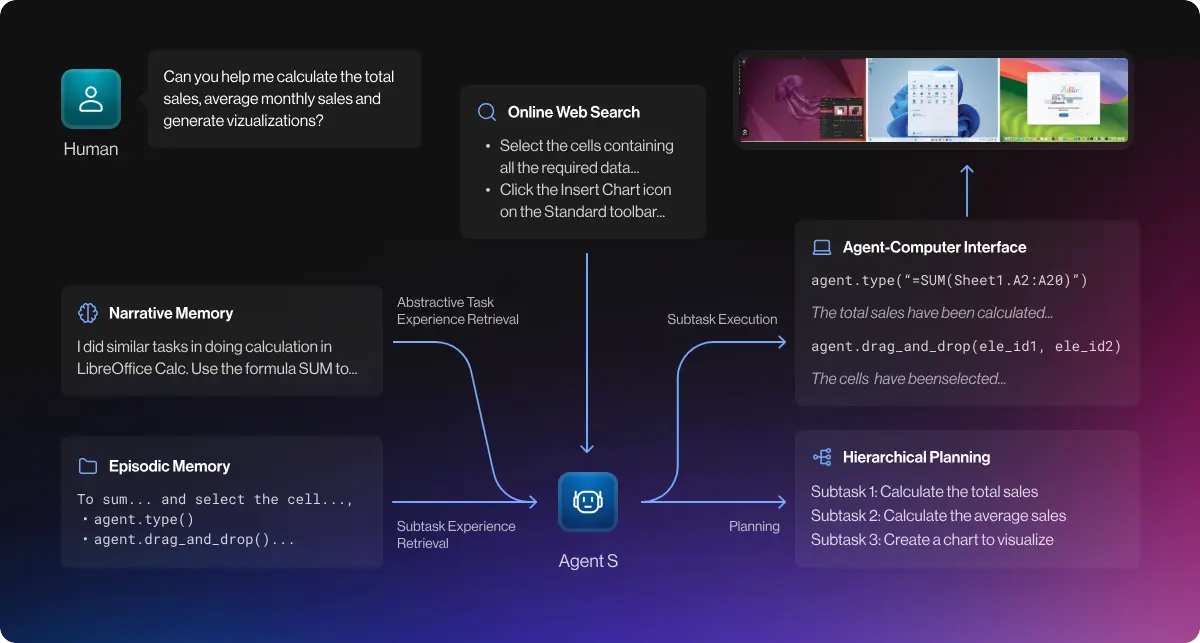
Agent S is an open-source framework that enables AI agents to interact with computers through graphical user interfaces (GUIs), mimicking human actions.
This design allows the automation of complex, multi-step tasks without relying on specialized scripts or APIs.
Agent S employs an experience-augmented hierarchical planning method, which combines online web knowledge and narrative memory to break down tasks into manageable subtasks.
This approach enables the agent to learn from past interactions and adapt to new challenges.
Landing AI's VisionAgent
VisionAgent is a tool developed by Landing AI to simplify the creation of vision-enabled applications. It generates code for computer vision tasks based on user prompts, selecting the most suitable models for specific needs.
VisionAgent acts as an orchestrator, utilizing specialized AI agents to reason through vision tasks and employing a curated set of vision tools.
This framework supports various applications, including object detection, image classification, and counting items, enabling developers to build vision-enabled apps efficiently.
These frameworks exemplify the advancements in AI agent development, offering tools that enhance the automation of tasks across different domains.
AI Agents in Retail (Salesforce Agentforce)
Salesforce’s Agentforce is a prime example of how AI agents are revolutionizing retail and customer relationship management (CRM).
This AI-powered system assists businesses in automating sales workflows, predicting customer needs, and personalizing interactions.
Retail businesses use Agentforce to analyze customer data, generate insights, and recommend personalized offers. The AI agent can detect customer intent based on past interactions and automatically suggest relevant products or services.
It also assists sales teams by handling repetitive tasks, such as lead qualification and follow-ups, allowing human employees to focus on closing deals.
By integrating AI agents like Agentforce, companies in retail and e-commerce can enhance customer engagement, boost sales, and streamline operations without increasing workforce costs.
NVIDIA’s Vision for AI Workforce Management
NVIDIA has been at the forefront of AI innovation, and its vision for AI-driven workforce management reflects the growing importance of AI agents in enterprise environments.
NVIDIA’s AI workforce initiatives focus on intelligent automation, where AI agents optimize employee productivity, automate workflows, and support complex decision-making.
NVIDIA’s AI agents help businesses manage large-scale operations by analyzing real-time data and making autonomous decisions. For example, in manufacturing, AI agents monitor production lines to predict maintenance needs and prevent system failures.
In corporate settings, AI workforce management tools assist HR teams in automating onboarding, training, and performance analysis.
These AI agents not only enhance efficiency but also ensure that businesses stay competitive in an increasingly automated world. By reducing dependency on human intervention, companies can scale operations more effectively.
Google’s Gemini 2 and Agentic Capabilities
Google’s Gemini 2 is a breakthrough in AI agent technology, offering advanced multimodal intelligence that allows it to process and analyze different types of data simultaneously, including text, images, and sensor inputs.
This enables Gemini 2 to serve as a powerful AI agent capable of handling diverse tasks across industries.
One of its standout features is its ability to function as an autonomous digital assistant that can interpret complex queries, execute actions, and assist users in making informed decisions.
For instance, in healthcare, Gemini 2 helps doctors analyze medical reports, detect anomalies in X-rays, and provide treatment recommendations. In finance, it assists with fraud detection and market trend analysis by scanning large datasets for irregular patterns.
By leveraging AI agents like Gemini 2, businesses and individuals gain access to more intelligent, adaptable, and efficient tools that enhance productivity and decision-making.
Freshworks’ Freddy AI in Customer Support
Customer support is one of the most impacted sectors by AI agents, and Freshworks’ Freddy AI is a prime example of how businesses are using AI-driven automation to enhance customer experiences.
Freddy AI acts as a virtual support agent, handling customer inquiries, troubleshooting issues, and even providing personalized responses based on past interactions.
Companies that use Freddy AI benefit from 24/7 automated support, reducing the burden on human agents and improving response times. Freddy AI is trained to detect sentiment, ensuring that it escalates complex or frustrated customer queries to human representatives when necessary.
Additionally, Freddy AI integrates with multiple customer support channels, including email, chat, and social media, ensuring seamless communication across platforms.
This AI agent helps businesses provide consistent, high-quality customer service while significantly reducing operational costs.
Benefits and Risks of AI Agents
AI agents offer significant advantages in automating processes, improving decision-making, and enhancing business operations.
However, they also come with challenges, including ethical concerns, security risks, and socioeconomic impacts.
Understanding both the benefits and risks helps businesses and researchers develop AI agents responsibly.
Benefits
Enhanced Efficiency and Scalability
AI agents can process vast amounts of information quickly and accurately. Unlike humans, they do not suffer from fatigue, making them ideal for repetitive or time-sensitive tasks.
AI agents in industries like healthcare, finance, and logistics help automate complex workflows, improving productivity and reducing human workload.
Their ability to scale operations ensures businesses can handle increasing demands without proportional increases in resources.
Data-Driven Decision-Making
AI agents analyze large datasets to identify patterns and trends that humans may overlook. By integrating machine learning models, these agents help businesses make informed decisions based on real-time and historical data.
For example, AI agents in finance detect fraudulent transactions, while those in healthcare assist doctors in diagnosing diseases by analyzing medical images and patient records.
24/7 Operations and Cost Savings
Unlike human employees, AI agents operate continuously without breaks. This ensures round-the-clock support for businesses, improving customer service and operational efficiency.
Many companies use AI-powered chatbots to handle customer inquiries, reducing the need for human support agents. Additionally, AI agents help cut costs by minimizing manual labor, reducing errors, and optimizing resource allocation.
Risks
Ethical Concerns (Bias, Privacy)
One of the major risks of AI agents is bias in decision-making. Since AI models learn from historical data, they can inherit biases present in the training datasets. This can lead to unfair treatment in areas like hiring, lending, and law enforcement.
Additionally, privacy concerns arise when AI agents process sensitive user data. Without proper safeguards, personal data can be misused or leaked, leading to security breaches and legal issues.
Technical Vulnerabilities (Security, Misuse)
AI agents are susceptible to cyberattacks and security vulnerabilities. Malicious actors can exploit weaknesses in AI systems, leading to data breaches, AI-generated misinformation, or automated cyber threats.
Ensuring robust security measures, including encryption, access control, and continuous monitoring, is essential to prevent AI misuse.
Socioeconomic Impact (Job Displacement)
As AI agents automate more tasks, concerns about job displacement grow. Industries that rely heavily on routine tasks, such as manufacturing, customer service, and data entry, are at higher risk of workforce reductions due to AI automation.
While AI creates new job opportunities in AI development, maintenance, and oversight, there is a need for workforce reskilling to adapt to the evolving job market.
Ethical and Societal Considerations
The rise of AI agents brings many ethical and societal challenges. While AI agents improve efficiency and decision-making, their impact on fairness, privacy, transparency, and accountability must be carefully managed.
Ensuring responsible AI development requires addressing bias, securing data, maintaining transparency, and keeping human oversight in AI decision-making.
Addressing Bias and Fairness
AI agents learn from historical data, which can contain biases. If not properly handled, AI models may reinforce discrimination in hiring, lending, law enforcement, and other areas.
For example, an AI-powered hiring agent trained on biased hiring data may unfairly reject certain candidates based on gender, ethnicity, or age.
To ensure fairness, developers must use diverse and unbiased training datasets, continuously monitor AI decisions, and implement fairness-aware algorithms that reduce discriminatory outcomes.
Privacy and Data Security Challenges
AI agents often process vast amounts of personal and sensitive data, including financial records, healthcare information, and user behaviors. Without strict security measures, this data can be exposed to cyber threats, unauthorized access, or misuse.
Organizations using AI agents must follow strong data protection practices, such as encryption, secure access controls, and compliance with regulations like GDPR and CCPA.
Maintaining privacy also means ensuring users have control over their data and understanding how AI systems use it.
Transparency and Explainability
Many AI agents operate as "black boxes," making decisions without clear explanations. This lack of transparency raises concerns, especially in critical applications like healthcare, finance, and criminal justice.
If an AI model denies a loan or misdiagnoses a patient, the affected individuals need to understand why. Explainable AI (XAI) methods aim to make AI decisions interpretable by providing insights into how models reach conclusions.
Organizations must prioritize transparency by designing AI agents that can justify their actions in human-understandable terms.
Human Oversight and Accountability
AI agents should not operate without human supervision, especially in high-risk applications. While AI can assist decision-making, humans must remain in control to ensure ethical and responsible outcomes.
If an AI agent makes a critical error, such as approving a faulty financial transaction or making a biased legal judgment, accountability mechanisms must be in place.
Governments and businesses must implement AI governance frameworks, ensuring human oversight and intervention in cases where AI-driven decisions may have unintended consequences.
AI Agents in Political Deliberation
AI agents are increasingly being explored for their role in political deliberation, where they can assist in analyzing policy documents, summarizing discussions, and moderating debates.
However, this raises concerns about manipulation, misinformation, and bias. AI-driven systems used in elections, policy-making, or online discussions must be carefully designed to avoid reinforcing existing biases or influencing public opinion unfairly.
Transparency in AI-driven political processes is crucial to maintaining trust in democratic systems.
Addressing these ethical and societal challenges requires collaboration between AI developers, businesses, policymakers, and researchers. As AI agents become more advanced, prioritizing fairness, privacy, transparency, and human oversight will be essential to ensuring AI benefits society without causing unintended harm.
Future Trends and Innovations
The development of AI agents is advancing rapidly, and the future holds exciting possibilities. AI agents are expected to become more autonomous, adaptable, and deeply integrated into various industries.
Innovations in AI will focus on enhancing personalization, security, and intelligence while reducing the need for human intervention in routine decision-making.
Increased Autonomy and Hyper-Personalization
AI agents are evolving from simple rule-based systems to highly autonomous entities capable of complex decision-making.
Future AI agents will not only respond to user commands but also anticipate needs and make proactive decisions based on learned patterns.
Hyper-personalization will allow AI agents to provide tailored recommendations, automate workflows based on user behavior, and continuously adapt to changing environments.
From AI-driven customer service to intelligent virtual assistants, hyper-personalization will enhance user experience across industries.
Integration with Emerging Technologies
AI agents will not function in isolation but will integrate with cutting-edge technologies to enhance their capabilities.
- Quantum Computing: AI agents will leverage quantum computing to process vast datasets faster than classical computers. This will improve AI models’ ability to perform complex simulations, optimize large-scale logistics, and enhance cryptographic security.
- Blockchain: AI agents integrated with blockchain technology will enhance transparency, security, and trust in data transactions. Smart contracts powered by AI agents will automate legal agreements, supply chain verification, and digital identity authentication.
- Multimodal AI (Text, Image, Sensor Data): Future AI agents will process and combine multiple types of data—text, images, videos, and sensor inputs—to make more informed decisions. This will improve applications like self-driving cars, medical diagnostics, and smart surveillance systems.
Self-Healing Systems and Democratized Development
AI agents will become more self-sufficient through self-healing capabilities. These systems will detect errors, optimize their own algorithms, and autonomously correct performance issues.
This will reduce downtime in critical applications such as healthcare, finance, and industrial automation.
Additionally, AI development will become more democratized. With user-friendly platforms and no-code/low-code AI development tools, non-technical users will be able to create and deploy AI agents without requiring extensive programming knowledge.
This will lead to increased adoption of AI agents across businesses and individuals.
AI-Driven Fourth Industrial Revolution
AI agents are at the forefront of the Fourth Industrial Revolution, where automation, IoT, and AI-driven decision-making will dominate industries. Factories will use AI agents for predictive maintenance and real-time production adjustments.
AI-powered supply chain optimization will reduce costs and minimize delays. In healthcare, AI agents will analyze patient data and provide precise diagnoses, enhancing patient outcomes. This revolution will drive unprecedented efficiency and innovation in every sector.
Research and Development in 2025
The AI agent landscape is heavily influenced by research advancements. The latest AI breakthroughs in 2025 focus on making AI agents more intelligent, ethical, and capable of operating in real-world environments.
Top AI Agent Research Papers (arXiv, January 2025)
- API-Based Web Agents: AI agents are being designed to integrate seamlessly with web-based services and APIs, enabling them to automate online workflows, retrieve real-time data, and perform complex online transactions.
- Governance Frameworks: Research is exploring how to regulate and guide AI agents to ensure ethical usage, prevent bias, and maintain compliance with global standards.
- DeepSeek-R1 Reasoning Models: Advanced reasoning models are enhancing AI agents' ability to solve problems, make decisions, and generate logical inferences in complex environments.
Market Projections and Industry Growth
The AI agent market is experiencing exponential growth. In 2024, the market was valued at $5.1 billion, and projections indicate it will reach $47.1 billion by 2030.
This rapid expansion is driven by increased demand for AI automation in industries such as healthcare, finance, and e-commerce.
- Vertical AI Agents Dominance: AI agents designed for specific industries (vertical AI) will dominate the market.
Companies are shifting from general AI assistants to highly specialized agents that cater to niche industries, such as AI-powered legal assistants, automated financial advisors, and precision agriculture AI tools.
Implementation Strategies
The successful adoption of AI agents depends on well-planned implementation strategies. Organizations must ensure AI agents integrate seamlessly with existing systems, gain user trust, and continuously improve their performance.
A structured approach to adoption, integration, and architecture can help maximize the benefits of AI agents while minimizing risks.
Overcoming Adoption Challenges
Many businesses hesitate to adopt AI agents due to concerns about reliability, bias, and job displacement. Addressing these challenges requires a mix of trust-building, transparent AI processes, and gradual deployment.
- Trust Building and Explainability: Users and decision-makers must trust AI agents before relying on them for critical tasks.
Providing clear explanations of how AI agents make decisions improves transparency and user confidence.
Explainable AI (XAI) methods, such as highlighting reasoning paths or offering justifications for decisions, help businesses build trust in AI-powered workflows. - Incremental Deployment: Organizations can start by implementing AI agents in non-critical areas, such as automating customer service responses or assisting with data analysis.
As trust in AI grows, companies can expand the scope of AI agents to handle more complex decision-making tasks. This gradual approach reduces resistance and allows teams to adapt.
Integrating AI Agents with Human Teams
For AI agents to be effective, they must complement human work rather than replace it. Successful integration requires clear role assignments and continuous feedback mechanisms.
- Task Identification and Role Assignment: Organizations must define the specific tasks AI agents will handle and determine how they will interact with human teams.
AI agents can take over repetitive, time-consuming tasks, allowing employees to focus on high-value work. For example, in healthcare, AI agents can analyze patient data, while doctors make final diagnoses. - Feedback Loops and Continuous Learning: AI agents must continuously improve based on user feedback. Implementing real-time feedback loops ensures that AI models learn from mistakes and refine their responses.
In industries like finance, AI agents can detect fraud patterns more accurately over time by incorporating human feedback on false positives and negatives.
Best Practices for Architecture
The architecture of AI agents plays a critical role in their effectiveness, scalability, and adaptability. Organizations should focus on modular design and hybrid AI approaches to maximize flexibility and efficiency.
- Modular Design: AI agents should be built using a modular approach, where different components (such as natural language processing, machine learning, and data retrieval) function independently but communicate effectively.
This makes it easier to update and scale AI agents without disrupting the entire system. - Hybrid AI Approaches: Combining rule-based logic with machine learning improves AI agent performance.
While machine learning models handle complex decision-making, rule-based logic ensures compliance with business policies and regulatory requirements.
Hybrid approaches allow AI agents to make faster and more accurate decisions while maintaining control and oversight.
Conclusion
AI agents are reshaping industries by automating workflows, improving efficiency, and enabling smarter decision-making. From retail and finance to healthcare and manufacturing, businesses are leveraging AI agents to enhance productivity and deliver better customer experiences.
As AI technology advances, these agents will become even more autonomous, adaptable, and essential in daily operations.
While AI agents offer numerous benefits, they also raise concerns about bias, data privacy, and job displacement. Companies must implement ethical AI practices, ensuring transparency, fairness, and security.
Human oversight remains essential to maintaining trust and preventing unintended consequences in AI-driven decision-making.
AI agents are becoming a critical part of the digital ecosystem. Businesses and individuals must prepare for a future where AI-driven automation is the norm.
Investing in AI education, ethical frameworks, and scalable solutions will help organizations maximize the benefits of AI while minimizing risks.
By embracing responsible AI development, industries can unlock new opportunities and drive innovation in a way that benefits both businesses and society.
FAQs
What are AI agents?
AI agents are autonomous systems that can perceive their environment, process information, and take action to achieve specific goals. They range from simple rule-based bots to advanced AI-powered decision-makers used in industries like finance, healthcare, and e-commerce.
How do AI agents work?
AI agents use technologies like machine learning, natural language processing (NLP), computer vision, and reinforcement learning to analyze data, make decisions, and perform tasks. They follow structured workflows and can integrate with various automation tools.
How are AI agents different from chatbots?
Chatbots are a type of AI agent focused on text-based interactions, often used for customer support. AI agents, on the other hand, can perform more complex tasks like workflow automation, decision-making, and data processing beyond simple conversations.
What are the main types of AI agents?
AI agents can be classified by intelligence level (simple reflex, model-based, goal-based, utility-based, learning agents) or functionality (conversational agents, task-oriented agents, multi-agent systems). They can also be categorized as general-purpose or industry-specific AI agents.
References

Simplify Your Data Annotation Workflow With Proven Strategies
.png)


